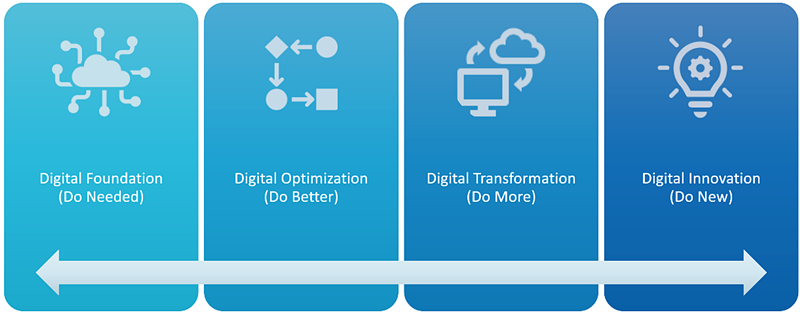The digital journey is no longer an aspiration or nice-to-have; it is an essential focus for every organization. The era of digital transformation is changing the way businesses operate. A strategic approach to digital transformation with planned investments in technology and people is required to help organizations succeed in the digital economy. Strategic digital investments made today decide the future shape of the organizations, and their ability to sustain and grow.
It is easy to say that companies should invest in digital programs, but how do they identify which opportunities are worth the investment? Without a holistic approach, these efforts will likely fail, or at best, take far longer to reach desired objectives. Should you focus on customer experience first and put off the employee experience? Should you prioritize customer acquisition over new product development, or new business models? Should you focus on innovation or process efficiencies, or instead, hone in on democratizing data access?
Four Digital Investment Themes
Strategic planning is a process that every organization follows to ensure that it stays on the right path. It's a way of thinking about the future and how an organization can best achieve its goals. To accelerate the digital journey, organizations need a holistic approach with a balanced focus on foundational blocks, customers, employees, products or services, data, innovation and new business models.
Here are four strategic investment themes to develop a digital portfolio to transform your organization into an intelligent enterprise: 1. Digital Foundation, 2. Digital Optimization, 3. Digital Transformation, and 4. Digital Innovation.

All four investment themes can run in parallel. Depending on an organization's digital journey, the mix might change year over year. For example, one company may decide to have 60 percent of the investment in Digital Foundation this year, and reduce it to 40 percent next year so as to increase investments in one or more of the other three areas.
1. Digital Foundation – Do needed
To understand the meaning of Digital Foundation, just think about the foundation of a big house. A solid foundation of concreate or steel is necessary to make the house stand for decades, under various conditions. Foundation initiatives may not be visible to your business users and end customers, but they are essential for the success of other visible initiatives.
Some of the examples of Digital Foundation initiatives are:
- Infrastructure reliability improvements
- Cloud migration initiatives for efficiencies
- Cyber security practices to improve controls
- IT governance for business alignment and risk management
- Enterprise architecture for application portfolio management
- Data platforms for consolidation and quality improvements
A critical distinction from the house foundation metaphor is that you don't have to wait to have all the foundational blocks ready to start other part of your digital journey: Optimization, Transformation, and/or Innovation. These initiatives can be managed in parallel to each other, with careful attention to managing dependencies, avoiding technical debt, and addressing business priorities.
2. Digital Optimization – Do better
The primary focus of digital optimization initiatives is improving the efficiencies and competencies of existing processes. These initiatives are not intended to replace existing business practices but to eliminate unnecessary steps in the processes, reduce friction and improve employee productivity and customer experience.
Some examples of Digital Optimization initiatives are:
- Process mining and optimization
- Robotic Process Automation (RPA)
- Training and tools for employees
- Application consolidation with reduced complexities
- Data-driven insights for operation and tactical decision making
- Analytical capabilities and business intelligence
Digital optimization initiatives are focused on "doing better" without disrupting existing business processes. As a result, the outcome horizon from these programs can be less than digital transformation initiatives.
|
Related article: Planning Digital Transformation? Document your assumptions and risks By Jim Maholic |
3. Digital Transformation - Do more
The Digital Transformation portfolio consists of initiatives that build new capabilities to improve business performance, migrate from legacy applications, create new products or services, and create new customer engagement channels. These initiatives require significant investments and will directly impact the business units' performance and growth.
Some examples of Digital Transformation initiatives are:
- Programs to eliminate legacy and paper-based practices
- Business process reengineering with improved outcomes
- Migrate on-premise applications to Software-as-a-Service options
- Implementing leading CRM platforms like Salesforce to improve lead funnels or service management
- Implementing better supplier management systems like SAP Ariba
- Modernize HR practices with proven apps like SAP SuccessFactors
- Building Data Science and Machine Learning capabilities to provide actionable insights with advanced analytics
These initiatives push organizations to do more than they were doing before, and may even disrupt old practices. Even though these programs cause some discomfort of change, when properly executed they can produce remarkable outcomes.
4. Digital Innovation – Do new
All companies desire innovation, but not every company can commit to budgets and implement an experimentation culture. Even when there are passionate employees with ideas to innovate, an outdated funding model or corporate bureaucracy may squash such initiatives.
Having a fund bucket for digital innovation encourages experimentation. Digital technologies allow for experimentation with less financial commitment or time. Experiments can lead to new products or services and even new business models. Although not every experiment has to create groundbreaking outcomes, many can provide valuable learnings on what works and what doesn't work for a business. These lessons can save money and time by keeping larger investments out of the wrong initiatives.
Some examples of Digital Innovation initiatives are:
- Machine learning experiments with inside and outside data
- Data exploration using analytical tools for possible new insights
- Learning initiatives from within the same industry, and from different industries
- Collaborate with startups to experiment
- Fund university research programs or sponsor hackathons
- Leverage the cloud to explore the art of possibilities with services like text analytics, chatbots, data storage types, artificial intelligence, and machine learning models.
- Setup new websites for market experimentations and run campaigns
- Experiments with drones, VR, AR and IoT technologies
These experiments, learnings, and failures will ignite the teams' creativity with the art of the possible, which also helps strengthen the organization's culture of innovation.
Conclusion
These four strategic investment themes give you a framework to balance the investments while improving operational efficiencies and transforming the business to be a digital enterprise. They can be seen as investment buckets.
Digital Transformation is a journey, not a destination. Therefore, the primary purpose of the digital journey is to develop a direction and initiate appropriate programs to leverage digital technologies to sustain a competitive advantage, strengthen core operations and grow the business.

Written by Raj Polanki
Raj Polanki is a divisional CIO at Wacker Chemical Corporation. He has 25+ years of experience in progressive and influential leadership positions at global companies. He is also an author, speaker, and recognized thought leader. Polanki earned an Advanced Executive Certificate from MIT Sloan, and an MBA from Ross Business School at University of Michigan. He is passionate about helping future technology leaders through Future CIO Club.



